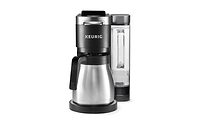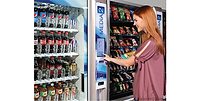Technology, healthy lifestyles shape vending channel
Beverage companies utilize latest technology to reach younger consumers

Imagine walking within range of a vending machine and receiving a mobile notification that your favorite drink is cold and waiting for you just steps away. That’s the future of vending, thanks to new loyalty programs and next-generation technology, according to Scott Corley, vice president of Foodservice On-Premise and Vending for Atlanta-based Coca-Cola North America.
Increased data proliferation allows vendors to personalize the vending experience for consumers and — from an operational standpoint — track which products are most popular where and respond accordingly.
“The Coca-Cola Co. offers more than 800 products across 100 brands in the United States, so insights about the specific consumers in each market by occasion [can] help us place the right products in the right vending assets,” Corley explains.
Furthermore, technology allows vendors to engage customers with touchscreens featuring ads and bundled purchase options to drive higher sales, says Chuck Reed, vice president and general manager of CPI Vending, Malvern, Pa.
Scott Finlow, chief marketing officer for PepsiCo Global Foodservice, adds: “New data and artificial intelligence, automation, and the Internet of Things are creating massive disruptions across society. Increasingly, people demand speed and ease throughout their day, wherever they’re making food and beverage choices. Based on our understanding of what on-the-go consumers are looking for when they are at work, on campus or shopping online, we continue to explore innovative, disruptive and on-trend ways to meet operator and consumer needs.”
One of the most popular ways to meet consumer needs is via cashless payment.
“Cashless payment acceptance in addition to cash typically generates 15-25 percent incremental sales because taking all forms of consumer payment opens up the vending machine to a wider consumer base,” CPI Vending’s Reed says.
Younger consumers generally prefer cashless payment options, which also persuades many vending operators to invest in cashless solutions, he adds.
However, vending operators should be sure to consider all the variables before updating their machines, Reed says. He calls attention to a connection fee and transaction cost that should be considered when evaluating a return on investment (ROI). “Location, existing sales levels, public/private site [and] demographics all play into whether a sufficient ROI can be generated by adding cashless acceptance at the machine,” he adds.
It’s also important to note that “connected” vending machines likely will require continual investments to keep up with the times. For instance, the gradual proliferation of 5G technology could challenge the channel.
“As 5G technology expands across the United States, we will be making even more investments to ensure that the cashless systems available on our machines match the even more advanced technology that will be required,” Coca-Cola’s Corley says.
More Nutritious Options
Although tech-savvy vending machines are in demand, they’re not the only things consumers are seeking. A few years ago, PepsiCo surveyed its consumers and found that two-thirds rarely have or never used a vending machine, Finlow says. “There were a lot of reasons for this, but the one we kept hearing over and over again is that they wanted more nutritious on-the-go options and a more modern experience, including options to pay by card or phone.”
To answer the request for more nutritious options, PepsiCo launched the Hello Goodness platform in 2015.
“Today, Hello Goodness features many lower calorie or more nutritious products from PepsiCo’s broad food and beverage portfolio in more than 50,000 units — including vending machines, coolers and racks — in market,” Finlow says.
Hello Goodness machines accept cashless payment options, including Apple Pay and credit cards, and provide a touchscreen interface that allows consumers to buy multiple products in one transaction, view nutritional information, and get suggestions for food and beverage bundles, Finlow explains.
More recently, PepsiCo launched a new hydration platform that reflects the rise in consumption of low- and no-sugar drinks as well as the growing demand for more sustainable packaging. Fittingly launched on April 22 — Earth Day — the new system enables consumers to bypass plastic packaging and enjoy a PepsiCo beverage from their own container. It consists of a beverage dispenser, smartphone app and personalized QR code sticker that allows consumers’ reusable bottles to be easily recognized by the dispenser.
“Reflecting how people now utilize technology and apps to track and personalize every element of their day, this ecosystem also allows users to set their own daily hydration goals and automatically tracks their way to meeting them,” Finlow explains. “Additionally, it tracks their environmental impact with a unique count of plastic bottles saved with each pour as well as over time saves unique preferences (like favorite flavors and carbonation levels) for future use.”
Furthermore, PepsiCo, The Coca-Cola Co. and Plano, Texas-based Dr Pepper Snapple Group, now operating as Keurig Dr Pepper, launched the Calories Count Vending Program in 2013 to encourage healthier choices. The program displays calorie information on vending machines and increases the availability of lower-calorie options, thereby encouraging consumers to make low-calorie choices.
The industry also utilizes the FitPick labeling program, created by the National Automatic Merchandising Association (NAMA) in 2005. The program was designed to make better-for-you products easier to identify in vending machines and micro markets. This year’s NAMA Show, which took place April 24-26 in Las Vegas, further demonstrated the healthy vending trend. Weeks before the show started, its “Better for You” Pavilion broke records, boasting more than 3,300 square feet and more than 30 exhibiting companies.
What young people want
The demand for cashless payment options, healthier choices, personalization and convenience primarily stems from young people, according to experts.
“Younger consumers are less likely to carry cash but always have their smartphones with them, which has prompted the vending channel to start accepting mobile, cashless payments,” Coca-Cola’s Corley says. “We’ve also seen young people shape vending through their desires for more information, variety of choice, personalization digitization and immediacy.”
To make consumption of its products as convenient for young people as possible, PepsiCo recently introduced snackbot by Hello Goodness for college students at the University of the Pacific in Stockton, Calif. Launched in collaboration with Bay Area-based Robby Technologies, snackbot is an outdoor, self-driving robot that delivers snacks and beverages directly to the consumer.
“Snackbot makes snacking more convenient than ever by allowing students to place an order directly from their mobile phone,” Finlow explains. “… Snackbot is the first consumer packaged goods brand-backed robot providing great-tasting, more nutritious snacks and beverages directly to students.”
Whether a vending machine offers cashless payment, a variety of healthy beverage options, or even drives itself to the consumer for ease of convenience, it’s clear the vending channel isn’t skimping on innovation. BI
Looking for a reprint of this article?
From high-res PDFs to custom plaques, order your copy today!






